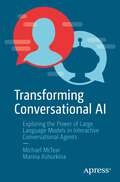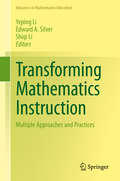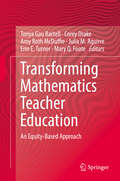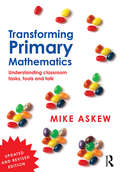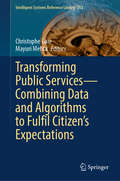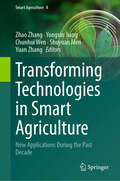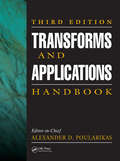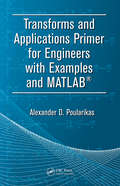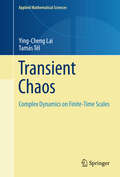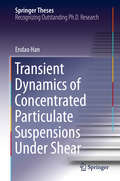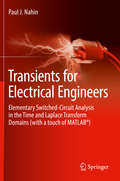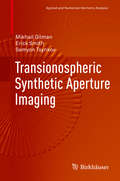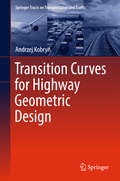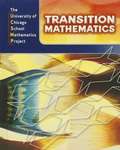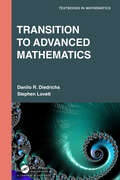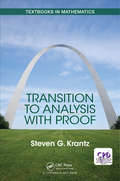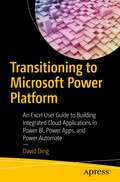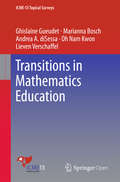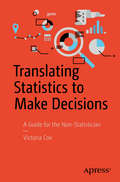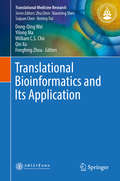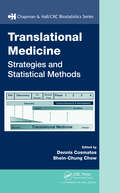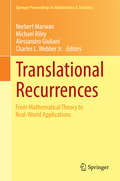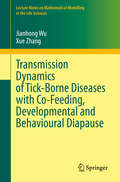- Table View
- List View
Transforming Conversational AI: Exploring the Power of Large Language Models in Interactive Conversational Agents
by Michael McTear Marina AshurkinaAcquire the knowledge needed to work effectively in conversational artificial intelligence (AI) and understand the opportunities and threats it can potentially bring. This book will help you navigate from the traditional world of dialogue systems that revolve around hard coded scripts, to the world of large language models, prompt engineering, conversational AI platforms, multi-modality, and ultimately autonomous agents.In this new world, decisions are made by a system that may forever remain a ‘black box’ for most of us. This book aims to eliminate unnecessary noise and describe the fundamental components of conversational AI. Past experiences will prove invaluable in constructing seamless hybrid systems. This book will provide the most recommended solutions, recognizing that it is not always necessary to blindly pursue new tools.Written in unprecedented and turbulent times for conversational interfaces you’ll see that despite previous waves of advancement in conversational technology, now conversational interfaces are gaining unparalleled popularity. Specifically, the release of ChatGPT in November 2022 by Open AI revolutionized the conversational paradigm and showed how easy and intuitive communication with a computer can be. Old professions are being disrupted, new professions are emerging, and even the most conservative corporations are changing their strategy and experimenting with large language models, allocating an unprecedented amount of budget to these projects. No one knows for sure the exact future of conversational AI, but everyone agrees that it’s here to stay. What You'll Learn See how large language models are constructed and used in conversational systems Review the risks and challenges of new technologies in conversational AI Examine techniques for prompt engineering Enable practitioners to keep abreast of recent developments in conversational AI Who This Book Is For Conversation designers, product owners, and product or project managers in conversational AI who wish to learn about new methods and challenges posed by the recent emergence in the public domain of ChatGPT. Data scientists, final year undergraduates and graduates of computer science
Transforming Mathematics Instruction
by Yeping Li Edward A. Silver Shiqi LiThis book surveys and examines different approaches and practices that contribute to the changes in mathematics instruction, including (1) innovative approaches that bring direct changes in classroom instructional practices, (2) curriculum reforms that introduce changes in content and requirements in classroom instruction, and (3) approaches in mathematics teacher education that aim to improve teachers' expertise and practices. It also surveys relevant theory and methodology development in studying and assessing mathematics instruction. Classroom instruction is commonly seen as one of the key factors contributing to students' learning of mathematics, but much remains to be understood about teachers' instructional practices that lead to the development and enactment of effective classroom instruction, and approaches and practices developed and used to transform classroom instruction in different education systems. Transforming Mathematics Instruction is organized to help readers learn not only from reading individual chapters, but also from reading across chapters and sections to explore broader themes, including: - Identifying what is important in mathematics for teaching and learning emphasized in different approaches; - Exploring how students' learning is considered and facilitated through different approaches and practices; - Understanding the nature of various approaches that are valued in different systems and cultural contexts; - Probing culturally valued approaches in identifying and evaluating effective instructional practices. The book brings new research and insights into multiple approaches and practices for transforming mathematics instruction to the international community of mathematics education, with 25 chapters and four section prefaces contributed by 56 scholars from 10 different education systems. This rich collection is indispensable reading for mathematics educators, researchers, teacher educators, curriculum developers, and graduate students interested in learning about different instructional practices, approaches for instructional transformation, and research in different education systems. It will help readers to reflect on approaches and practices that are useful for instructional changes in their own education systems, and also inspire them to identify and further explore new areas of research and program development in improving mathematics teaching and learning.
Transforming Mathematics Teacher Education: An Equity-Based Approach
by Erin E. Turner Tonya Gau Bartell Corey Drake Amy Roth McDuffie Julia M. Aguirre Mary Q. FooteThis book builds on the Teachers Empowered to Advance Change in Mathematics (TEACH Math) project, which was an initiative that sought to develop a new generation of preK-8 mathematics teachers to connect mathematics, children’s mathematical thinking, and community and family knowledge in mathematics instruction – or what we have come to call children’s multiple mathematical knowledge bases in mathematics instruction, with an explicit focus on equity. Much of the work involved in the TEACH Math project included the development of three instructional modules for preK-8 mathematics methods courses to support the project’s goals. These activities were used and refined over eight semesters, and in Fall 2014 shared at a dissemination conference with other mathematics teacher educators from a variety of universities across the United States. Chapter contributions represent diverse program and geographical contexts and teach prospective and practicing teachers from a variety of socioeconomic and ethnic backgrounds, in particular providing accounts of supports, challenges, and tensions in implementing equity-based mathematics teacher education. The chapters supply rich evidence and illustrative examples of how other mathematics teacher educators and professional developers might make the modules work for their unique practices, courses, workshops, and prospective teachers/teachers. It promises to be an important resource for offering guidance and examples to those working with prospective teachers of mathematics who want to create positive, culturally responsive, and equity-based mathematics experiences for our nation’s youth.
Transforming Primary Mathematics: Understanding classroom tasks, tools and talk
by Mike AskewFully updated to reflect the new curriculum, the revised edition of Transforming Primary Mathematics sets out key theories and cutting-edge research in the field to enable teachers to take a fresh look at how they teach mathematics. The book encourages teachers to reflect on their own beliefs and values about mathematics, and asks them to question whether their current methods meet the needs of all learners, and the challenge of having high expectations for all. It provides clear, practical approaches to help implement fundamental change in classroom environments, and offers motivational teaching styles to ensure meaningful mathematics learning. Chapters take an inspiring, sometimes controversial, and often unconventional look at the subject of mathematics, by: endorsing the use of a 'new mathematics' - one based on problem solving, modelling, inquiry and reasoning, not on abstract rules, memorising, and regurgitation arguing that there is more to maths teaching than 'death by a thousand worksheets' challenging norms, such as the practice of sorting children into sets based on their perceived mathematical ability asking whether mathematical ability is innate or a result of social practices examining what a 'mastery' approach might entail highlighting the role of variation in supporting learning advocating an environment where teachers are encouraged to take risks. Transforming Primary Mathematics is for all primary school teachers who want to make mathematics welcoming, engaging, inclusive and successful.
Transforming Public Services—Combining Data and Algorithms to Fulfil Citizen’s Expectations (Intelligent Systems Reference Library #252)
by Mayuri Mehta Christophe GaieThis book provides a precise portrayal of the current trends and future perspectives of e-Government. It outlines new approaches that optimize public services across diverse sectors. Going beyond traditional boundaries, it offers mathematical models for public services supported by convincing case studies. This book significantly enhances various government services, such as education, healthcare, safety, security, and culture. It also strongly emphasizes safeguarding citizens' personal data, ensuring privacy, and obtaining explicit consent. Tailored for students and academics, the book is an invaluable reference for teaching graduate courses in e-Government, Process Modelling, or Artificial Intelligence. Its impact extends beyond the classroom; civil servants from all domains can find practical insights to navigate the ongoing modernization of public services. Even citizens curious about the transformation in their public services can find this book enlightening. Researchers working in the area of e-Governance can use this book to discover the recent developments in e-Government.
Transforming Technologies in Smart Agriculture: New Applications During the Past Decade (Smart Agriculture #8)
by Zhao Zhang Yuan Zhang Yongxin Jiang Chunhui Wen Shuyuan MenThis book collects transforming technologies in smart agriculture and their applications during the past decade. It focuses on the latest sensing and automation technologies for field and specialty crop production, and provides a lot of innovative knowledge on imaging processing, AI algorithms, robotics, and their applications in agriculture. It provides undergraduate or graduate students take-away knowledge for unmanned agriculture production, including but not limited to, corn/wheat disease detection, cotton yield prediction, and apple detection. Furthermore, this book includes review reports on plant phenotyping sensing and automation technologies and techniques for aphid detection.
Transforms and Applications Handbook (The Electrical Engineering Handbook)
by Alexander D. PoularikasUpdating the original, Transforms and Applications Handbook, Third Edition solidifies its place as the complete resource on those mathematical transforms most frequently used by engineers, scientists, and mathematicians. Highlighting the use of transforms and their properties, this latest edition of the bestseller begins with a solid introduction to signals and systems, including properties of the delta function and some classical orthogonal functions.It then goes on to detail different transforms, including lapped, Mellin, wavelet, and Hartley varieties. Written by top experts, each chapter provides numerous examples and applications that clearly demonstrate the unique purpose and properties of each type. The material is presented in a way that makes it easy for readers from different backgrounds to familiarize themselves with the wide range of transform applications. Revisiting transforms previously covered, this book adds information on other important ones, including: Finite Hankel, Legendre, Jacobi, Gengenbauer, Laguerre, and Hermite Fraction Fourier Zak Continuous and discrete Chirp-Fourier Multidimensional discrete unitary Hilbert-Huang Most comparable books cover only a few of the transforms addressed here, making this text by far the most useful for anyone involved in signal processing—including electrical and communication engineers, mathematicians, and any other scientist working in this field.
Transforms and Applications Primer for Engineers with Examples and MATLAB® (Electrical Engineering Primer Series)
by Alexander D. PoularikasTransforms and Applications Primer for Engineers with Examples and MATLAB® is required reading for engineering and science students, professionals, and anyone working on problems involving transforms. This invaluable primer contains the most essential integral transforms that both practicing engineers and students need to understand. It provides a large number of examples to explain the use of transforms in different areas, including circuit analysis, differential equations, signals and systems, and mechanical vibrations. Includes an appendix with suggestions and explanations to help you optimize your use of MATLABLaplace and Fourier transforms are by far the most widely used and most useful of all integral transforms, so they are given a more extensive treatment in this book, compared to other texts that include them. Offering numerous MATLAB functions created by the author, this comprehensive book contains several appendices to complement the main subjects. Perhaps the most important feature is the extensive tables of transforms, which are provided to supplement the learning process. This book presents advanced material in a format that makes it easier to understand, further enhancing its immense value as a teaching tool for engineers and research scientists in academia and industry, as well as students in science and engineering.
Transient Chaos
by Ying-Cheng Lai Tamás TélThe aim of this Book is to give an overview, based on the results of nearly three decades of intensive research, of transient chaos. One belief that motivates us to write this book is that, transient chaos may not have been appreciated even within the nonlinear-science community, let alone other scientific disciplines.
Transient Dynamics of Concentrated Particulate Suspensions Under Shear (Springer Theses)
by Endao HanThis thesis demonstrates the first use of high-speed ultrasound imaging to non-invasively probe how the interior of a dense suspension responds to impact. Suspensions of small solid particles in a simple liquid can generate a rich set of dynamic phenomena that are of fundamental scientific interest because they do not conform to the typical behavior expected of either solids or liquids. Most remarkable is the highly counter-intuitive ability of concentrated suspensions to strongly thicken and even solidify when sheared or impacted. The understanding of the mechanism driving this solidification is, however, still limited, especially for the important transient stage while the response develops as a function of time. In this thesis, high-speed ultrasound imaging is introduced to track, for the first time, the transition from the flowing to the solidified state and directly observe the shock-like shear fronts that accompany this transition. A model is developed that agrees quantitatively with the experimental measurements. The combination of imaging techniques, experimental design, and modeling in this thesis represents a major breakthrough for the understanding of the dynamic response of dense suspensions, with important implications for a wide range of applications ranging from the handling of slurries to additive manufacturing.
Transients for Electrical Engineers: Elementary Switched-Circuit Analysis in the Time and Laplace Transform Domains (with a touch of MATLAB®)
by Paul J. NahinThis book offers a concise introduction to the analysis of electrical transients aimed at students who have completed introductory circuits and freshman calculus courses. While it is written under the assumption that these students are encountering transient electrical circuits for the first time, the mathematical and physical theory is not ‘watered-down.’ That is, the analysis of both lumped and continuous (transmission line) parameter circuits is performed with the use of differential equations (both ordinary and partial) in the time domain, and the Laplace transform. The transform is fully developed in the book for readers who are not assumed to have seen it before. The use of singular time functions (unit step and impulse) is addressed and illustrated through detailed examples.The appearance of paradoxical circuit situations, often ignored in many textbooks (because they are, perhaps, considered ‘difficult’ to explain) is fully embraced as an opportunity to challenge students. In addition, historical commentary is included throughout the book, to combat the misconception that the material in engineering textbooks was found engraved on Biblical stones, rather than painstakingly discovered by people of genius who often went down many wrong paths before finding the right one. MATLAB® is used throughout the book, with simple codes to quickly and easily generate transient response curves.
Transionospheric Synthetic Aperture Imaging
by Mikhail Gilman Erick Smith Semyon TsynkovThis landmark monograph presents the most recent mathematical developments in the analysis of ionospheric distortions of SAR images and offers innovative new strategies for their mitigation. As a prerequisite to addressing these topics, the book also discusses the radar ambiguity theory as it applies to synthetic aperture imaging and the propagation of radio waves through the ionospheric plasma, including the anisotropic and turbulent cases. In addition, it covers a host of related subjects, such as the mathematical modeling of extended radar targets (as opposed to point-wise targets) and the scattering of radio waves off those targets, as well as the theoretical analysis of the start-stop approximation, which is used routinely in SAR signal processing but often without proper justification. The mathematics in this volume is clean and rigorous - no assumptions are hidden or ambiguously stated. The resulting work is truly interdisciplinary, providing both a comprehensive and thorough exposition of the field, as well as an accurate account of a range of relevant physical processes and phenomena. The book is intended for applied mathematicians interested in the area of radar imaging or, more generally, remote sensing, as well as physicists and electrical/electronic engineers who develop/operate spaceborne SAR sensors and perform the data processing. The methods in the book are also useful for researchers and practitioners working on other types of imaging. Moreover, the book is accessible to graduate students in applied mathematics, physics, engineering, and related disciplines. Praise for Transionospheric Synthetic Aperture Imaging: "I perceive that this text will mark a turning point in the field of synthetic aperture radar research and practice. I believe this text will instigate a new era of more rigorous image formation relieving the research, development and practitioner communities of inconsistent physical assumptions and numerical approaches. " - Richard Albanese, Senior Scientist, Albanese Defense and Energy Development LLC
Transition Curves for Highway Geometric Design
by Andrzej KobryńThis book provides concise descriptions of the various solutions of transition curves, which can be used in geometric design of roads and highways. It presents mathematical methods and curvature functions for defining transition curves.
Transition Mathematics
by The University of Chicago School Mathematics Project Steven S. Viktora Erica CheungNIMAC-sourced textbook
Transition Mathematics Third Edition
by Steven S. Viktora Erica Cheung Virginia Highstone Catherine Capuzzi [et al.]Math textbook 6th to 12th Grades
Transition to Advanced Mathematics (Textbooks in Mathematics)
by Stephen Lovett Danilo R. DiedrichsThis unique and contemporary text not only offers an introduction to proofs with a view towards algebra and analysis, a standard fare for a transition course, but also presents practical skills for upper-level mathematics coursework and exposes undergraduate students to the context and culture of contemporary mathematics. The authors implement the practice recommended by the Committee on the Undergraduate Program in Mathematics (CUPM) curriculum guide, that a modern mathematics program should include cognitive goals and offer a broad perspective of the discipline. Part I offers: An introduction to logic and set theory. Proof methods as a vehicle leading to topics useful for analysis, topology, algebra, and probability. Many illustrated examples, often drawing on what students already know, that minimize conversation about "doing proofs." An appendix that provides an annotated rubric with feedback codes for assessing proof writing. Part II presents the context and culture aspects of the transition experience, including: 21st century mathematics, including the current mathematical culture, vocations, and careers. History and philosophical issues in mathematics. Approaching, reading, and learning from journal articles and other primary sources. Mathematical writing and typesetting in LaTeX. Together, these Parts provide a complete introduction to modern mathematics, both in content and practice. Table of Contents Part I - Introduction to Proofs Logic and Sets Arguments and Proofs Functions Properties of the Integers Counting and Combinatorial Arguments RelationsPart II - Culture, History, Reading, and Writing Mathematical Culture, Vocation, and Careers History and Philosophy of Mathematics Reading and Researching Mathematics Writing and Presenting Mathematics Appendix A. Rubric for Assessing Proofs Appendix B. Index of Theorems and Definitions from Calculus and Linear Algebra Bibliography Index Biographies Danilo R. Diedrichs is an Associate Professor of Mathematics at Wheaton College in Illinois. Raised and educated in Switzerland, he holds a PhD in applied mathematical and computational sciences from the University of Iowa, as well as a master’s degree in civil engineering from the Ecole Polytechnique Fédérale in Lausanne, Switzerland. His research interests are in dynamical systems modeling applied to biology, ecology, and epidemiology. Stephen Lovett is a Professor of Mathematics at Wheaton College in Illinois. He holds a PhD in representation theory from Northeastern University. His other books include Abstract Algebra: Structures and Applications (2015), Differential Geometry of Curves and Surfaces, with Tom Banchoff (2016), and Differential Geometry of Manifolds (2019).
Transition to Analysis with Proof (Textbooks in Mathematics)
by Steven Krantz<p>Transition to Real Analysis with Proof provides undergraduate students with an introduction to analysis including an introduction to proof. The text combines the topics covered in a transition course to lead into a first course on analysis. This combined approach allows instructors to teach a single course where two were offered. <p>The text opens with an introduction to basic logic and set theory, setting students up to succeed in the study of analysis. Each section is followed by graduated exercises that both guide and challenge students. The author includes examples and illustrations that appeal to the visual side of analysis. The accessible structure of the book makes it an ideal reference for later years of study or professional work.</p>
Transitional Mathematics: Understanding Algebraic Expressions, Student Textbook
by John Woodward Mary StrohNIMAC-sourced textbook
Transitioning to Microsoft Power Platform: An Excel User Guide to Building Integrated Cloud Applications in Power BI, Power Apps, and Power Automate
by David DingWelcome to this step-by-step guide for Excel users, data analysts, and finance specialists. It is designed to take you through practical report and development scenarios, including both the approach and the technical challenges. This book will equip you with an understanding of the overall Power Platform use case for addressing common business challenges. While Power BI continues to be an excellent tool of choice in the BI space, Power Platform is the real game changer. Using an integrated architecture, a small team of citizen developers can build solutions for all kinds of business problems. For small businesses, Power Platform can be used to build bespoke CRM, Finance, and Warehouse management tools. For large businesses, it can be used to build an integration point for existing systems to simplify reporting, operation, and approval processes.The author has drawn on his15 years of hands-on analytics experience to help you pivot from the traditional Excel-based reporting environment. By using different business scenarios, this book provides you with clear reasons why a skill is important before you start to dive into the scenarios. You will use a fast prototyping approach to continue to build exciting reporting, automation, and application solutions and improve them while you acquire new skill sets. The book helps you get started quickly with Power BI. It covers data visualization, collaboration, and governance practices. You will learn about the most practical SQL challenges. And you will learn how to build applications in PowerApps and Power Automate.The book ends with an integrated solution framework that can be adapted to solve a wide range of complex business problems.What You Will LearnDevelop reporting solutions and business applicationsUnderstand the Power Platform licensing and development environmentApply Data ETL and modeling in Power BIUse Data Storytelling and dashboard design to better visualize dataCarry out data operations with SQL and SharePoint listsDevelop useful applications using Power AppsDevelop automated workflows using Power AutomateIntegrate solutions with Power BI, Power Apps, and Power Automate to build enterprise solutionsWho This Book Is ForNext-generation data specialists, including Excel-based users who want to learn Power BI and build internal apps; finance specialists who want to take a different approach to traditional accounting reports; and anyone who wants to enhance their skill set for the future job market.
Transitions in Mathematics Education
by Ghislaine Gueudet Marianna Bosch Andrea A. A. Disessa Oh Nam Nam Kwon Lieven VerschaffelThis book examines the kinds of transitions that have been studied in mathematics education research. It defines transition as a process of change, and describes learning in an educational context as a transition process. The book focuses on research in the area of mathematics education, and starts out with a literature review, describing the epistemological, cognitive, institutional and sociocultural perspectives on transition. It then looks at the research questions posed in the studies and their link with transition, and examines the theoretical approaches and methods used. It explores whether the research conducted has led to the identification of continuous processes, successive steps, or discontinuities. It answers the question of whether there are difficulties attached to the discontinuities identified, and if so, whether the research proposes means to reduce the gap to create a transition. The book concludes with directions for future research on transitions in mathematics education. "
Translating Statistics to Make Decisions
by Victoria CoxExamine and solve the common misconceptions and fallacies that non-statisticians bring to their interpretation of statistical results. Explore the many pitfalls that non-statisticians—and also statisticians who present statistical reports to non-statisticians—must avoid if statistical results are to be correctly used for evidence-based business decision making. Victoria Cox, senior statistician at the United Kingdom’s Defence Science and Technology Laboratory (Dstl), distills the lessons of her long experience presenting the actionable results of complex statistical studies to users of widely varying statistical sophistication across many disciplines: from scientists, engineers, analysts, and information technologists to executives, military personnel, project managers, and officials across UK government departments, industry, academia, and international partners. The author shows how faulty statistical reasoning often undermines the utility of statistical results even among those with advanced technical training. Translating Statistics teaches statistically naive readers enough about statistical questions, methods, models, assumptions, and statements that they will be able to extract the practical message from statistical reports and better constrain what conclusions cannot be made from the results. To non-statisticians with some statistical training, this book offers brush-ups, reminders, and tips for the proper use of statistics and solutions to common errors. To fellow statisticians, the author demonstrates how to present statistical output to non-statisticians to ensure that the statistical results are correctly understood and properly applied to real-world tasks and decisions. The book avoids algebra and proofs, but it does supply code written in R for those readers who are motivated to work out examples. Pointing along the way to instructive examples of statistics gone awry, Translating Statistics walks readers through the typical course of a statistical study, progressing from the experimental design stage through the data collection process, exploratory data analysis, descriptive statistics, uncertainty, hypothesis testing, statistical modelling and multivariate methods, to graphs suitable for final presentation. The steady focus throughout the book is on how to turn the mathematical artefacts and specialist jargon that are second nature to statisticians into plain English for corporate customers and stakeholders. The final chapter neatly summarizes the book’s lessons and insights for accurately communicating statistical reports to the non-statisticians who commission and act on them. What You'll LearnRecognize and avoid common errors and misconceptions that cause statistical studies to be misinterpreted and misused by non-statisticians in organizational settingsGain a practical understanding of the methods, processes, capabilities, and caveats of statistical studies to improve the application of statistical data to business decisionsSee how to code statistical solutions in RWho This Book Is ForNon-statisticians—including both those with and without an introductory statistics course under their belts—who consume statistical reports in organizational settings, and statisticians who seek guidance for reporting statistical studies to non-statisticians in ways that will be accurately understood and will inform sound business and technical decisions
Translational Bioinformatics and Its Application
by Qin Xu Dong-Qing Wei Yilong Ma William C. S. Cho Fengfeng ZhouThis book offers a detailed overview of translational bioinformatics together with real-case applications. Translational bioinformatics integrates the areas of basic bioinformatics, clinical informatics, statistical genetics and informatics in order to further our understanding of the molecular basis of diseases. By analyzing voluminous amounts of molecular and clinical data, it also provides clinical information, which can then be applied. Filling the gap between clinic research and informatics, the book is a valuable resource for human geneticists, clinicians, health educators and policy makers, as well as graduate students majoring in biology, biostatistics, and bioinformatics.
Translational Medicine: Strategies and Statistical Methods
by Shein-Chung Chow Dennis CosmatosExamines Critical Decisions for Transitioning Lab Science to a Clinical SettingThe development of therapeutic pharmaceutical compounds is becoming more expensive, and the success rates for getting such treatments approved for marketing and to the patients is decreasing. As a result, translational medicine (TM) is becoming increasingly important in
Translational Recurrences
by Michael Riley Alessandro Giuliani Norbert Marwan Charles L. WebberThis book features 13 papers presented at the Fifth International Symposium on Recurrence Plots, held August 2013 in Chicago, IL. It examines recent applications and developments in recurrence plots and recurrence quantification analysis (RQA) with special emphasis on biological and cognitive systems and the analysis of coupled systems using cross-recurrence methods. Readers will discover new applications and insights into a range of systems provided by recurrence plot analysis and new theoretical and mathematical developments in recurrence plots. Recurrence plot based analysis is a powerful tool that operates on real-world complex systems that are nonlinear, non-stationary, noisy, of any statistical distribution, free of any particular model type and not particularly long. Quantitative analyses promote the detection of system state changes, synchronized dynamical regimes or classification of system states. The book will be of interest to an interdisciplinary audience of recurrence plot users and researchers interested in time series analysis of complex systems in general.
Transmission Dynamics of Tick-Borne Diseases with Co-Feeding, Developmental and Behavioural Diapause (Lecture Notes on Mathematical Modelling in the Life Sciences)
by Jianhong Wu Xue ZhangThis monograph introduces some current developments in the modelling of the spread of tick-borne diseases. Effective modelling requires the integration of multiple frameworks. Here, particular attention is given to the previously neglected issues of tick developmental and behavioral diapause, tick-borne pathogen co-feeding transmission, and their interactions. An introduction to the required basics of structured population formulations and delay differential equations is given, and topics for future study are suggested. The described techniques will also be useful in the study of other vector-borne diseases. The ultimate aim of this project is to develop a general qualitative framework leading to tick-borne disease risk predictive tools and a decision support system. The target audience is mathematical biologists interested in modelling tick population dynamics and tick-borne disease transmission, and developing computational tools for disease prevention and control.
